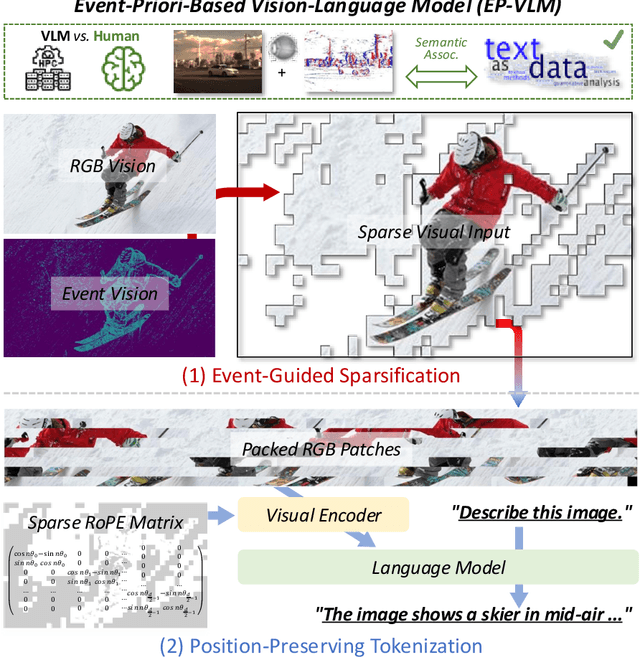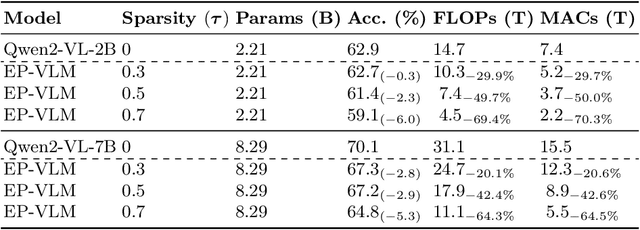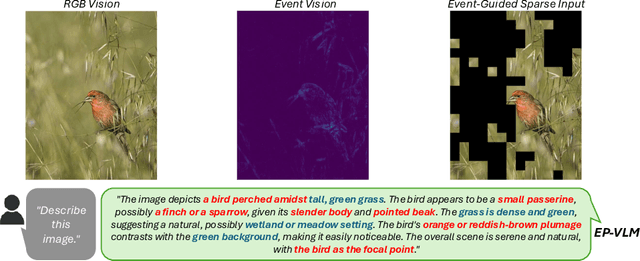Michele Magno
D-ITET, ETH Zürich, Switzerland
$\text{S}^2$Q-VDiT: Accurate Quantized Video Diffusion Transformer with Salient Data and Sparse Token Distillation
Aug 06, 2025Abstract:Diffusion transformers have emerged as the mainstream paradigm for video generation models. However, the use of up to billions of parameters incurs significant computational costs. Quantization offers a promising solution by reducing memory usage and accelerating inference. Nonetheless, we observe that the joint modeling of spatial and temporal information in video diffusion models (V-DMs) leads to extremely long token sequences, which introduces high calibration variance and learning challenges. To address these issues, we propose \textbf{$\text{S}^2$Q-VDiT}, a post-training quantization framework for V-DMs that leverages \textbf{S}alient data and \textbf{S}parse token distillation. During the calibration phase, we identify that quantization performance is highly sensitive to the choice of calibration data. To mitigate this, we introduce \textit{Hessian-aware Salient Data Selection}, which constructs high-quality calibration datasets by considering both diffusion and quantization characteristics unique to V-DMs. To tackle the learning challenges, we further analyze the sparse attention patterns inherent in V-DMs. Based on this observation, we propose \textit{Attention-guided Sparse Token Distillation}, which exploits token-wise attention distributions to emphasize tokens that are more influential to the model's output. Under W4A6 quantization, $\text{S}^2$Q-VDiT achieves lossless performance while delivering $3.9\times$ model compression and $1.3\times$ inference acceleration. Code will be available at \href{https://github.com/wlfeng0509/s2q-vdit}{https://github.com/wlfeng0509/s2q-vdit}.
EdgeCodec: Onboard Lightweight High Fidelity Neural Compressor with Residual Vector Quantization
Jul 08, 2025Abstract:We present EdgeCodec, an end-to-end neural compressor for barometric data collected from wind turbine blades. EdgeCodec leverages a heavily asymmetric autoencoder architecture, trained with a discriminator and enhanced by a Residual Vector Quantizer to maximize compression efficiency. It achieves compression rates between 2'560:1 and 10'240:1 while maintaining a reconstruction error below 3%, and operates in real time on the GAP9 microcontroller with bitrates ranging from 11.25 to 45 bits per second. Bitrates can be selected on a sample-by-sample basis, enabling on-the-fly adaptation to varying network conditions. In its highest compression mode, EdgeCodec reduces the energy consumption of wireless data transmission by up to 2.9x, significantly extending the operational lifetime of deployed sensor units.
PicoSAM2: Low-Latency Segmentation In-Sensor for Edge Vision Applications
Jun 24, 2025Abstract:Real-time, on-device segmentation is critical for latency-sensitive and privacy-aware applications like smart glasses and IoT devices. We introduce PicoSAM2, a lightweight (1.3M parameters, 336M MACs) promptable segmentation model optimized for edge and in-sensor execution, including the Sony IMX500. It builds on a depthwise separable U-Net, with knowledge distillation and fixed-point prompt encoding to learn from the Segment Anything Model 2 (SAM2). On COCO and LVIS, it achieves 51.9% and 44.9% mIoU, respectively. The quantized model (1.22MB) runs at 14.3 ms on the IMX500-achieving 86 MACs/cycle, making it the only model meeting both memory and compute constraints for in-sensor deployment. Distillation boosts LVIS performance by +3.5% mIoU and +5.1% mAP. These results demonstrate that efficient, promptable segmentation is feasible directly on-camera, enabling privacy-preserving vision without cloud or host processing.
Post-Training Quantization for Video Matting
Jun 12, 2025Abstract:Video matting is crucial for applications such as film production and virtual reality, yet deploying its computationally intensive models on resource-constrained devices presents challenges. Quantization is a key technique for model compression and acceleration. As an efficient approach, Post-Training Quantization (PTQ) is still in its nascent stages for video matting, facing significant hurdles in maintaining accuracy and temporal coherence. To address these challenges, this paper proposes a novel and general PTQ framework specifically designed for video matting models, marking, to the best of our knowledge, the first systematic attempt in this domain. Our contributions include: (1) A two-stage PTQ strategy that combines block-reconstruction-based optimization for fast, stable initial quantization and local dependency capture, followed by a global calibration of quantization parameters to minimize accuracy loss. (2) A Statistically-Driven Global Affine Calibration (GAC) method that enables the network to compensate for cumulative statistical distortions arising from factors such as neglected BN layer effects, even reducing the error of existing PTQ methods on video matting tasks up to 20%. (3) An Optical Flow Assistance (OFA) component that leverages temporal and semantic priors from frames to guide the PTQ process, enhancing the model's ability to distinguish moving foregrounds in complex scenes and ultimately achieving near full-precision performance even under ultra-low-bit quantization. Comprehensive quantitative and visual results show that our PTQ4VM achieves the state-of-the-art accuracy performance across different bit-widths compared to the existing quantization methods. We highlight that the 4-bit PTQ4VM even achieves performance close to the full-precision counterpart while enjoying 8x FLOP savings.
R-CARLA: High-Fidelity Sensor Simulations with Interchangeable Dynamics for Autonomous Racing
Jun 11, 2025Abstract:Autonomous racing has emerged as a crucial testbed for autonomous driving algorithms, necessitating a simulation environment for both vehicle dynamics and sensor behavior. Striking the right balance between vehicle dynamics and sensor accuracy is crucial for pushing vehicles to their performance limits. However, autonomous racing developers often face a trade-off between accurate vehicle dynamics and high-fidelity sensor simulations. This paper introduces R-CARLA, an enhancement of the CARLA simulator that supports holistic full-stack testing, from perception to control, using a single system. By seamlessly integrating accurate vehicle dynamics with sensor simulations, opponents simulation as NPCs, and a pipeline for creating digital twins from real-world robotic data, R-CARLA empowers researchers to push the boundaries of autonomous racing development. Furthermore, it is developed using CARLA's rich suite of sensor simulations. Our results indicate that incorporating the proposed digital-twin framework into R-CARLA enables more realistic full-stack testing, demonstrating a significant reduction in the Sim-to-Real gap of car dynamics simulation by 42% and by 82% in the case of sensor simulation across various testing scenarios.
Q-SAM2: Accurate Quantization for Segment Anything Model 2
Jun 11, 2025Abstract:The Segment Anything Model 2 (SAM2) has gained significant attention as a foundational approach for promptable image and video segmentation. However, its expensive computational and memory consumption poses a severe challenge for its application in resource-constrained scenarios. In this paper, we propose an accurate low-bit quantization method for efficient SAM2, termed Q-SAM2. To address the performance degradation caused by the singularities in weight and activation distributions during quantization, Q-SAM2 introduces two novel technical contributions. We first introduce a linear layer calibration method for low-bit initialization of SAM2, which minimizes the Frobenius norm over a small image batch to reposition weight distributions for improved quantization. We then propose a Quantization-Aware Training (QAT) pipeline that applies clipping to suppress outliers and allows the network to adapt to quantization thresholds during training. Our comprehensive experiments demonstrate that Q-SAM2 allows for highly accurate inference while substantially improving efficiency. Both quantitative and visual results show that our Q-SAM2 surpasses existing state-of-the-art general quantization schemes, especially for ultra-low 2-bit quantization. While designed for quantization-aware training, our proposed calibration technique also proves effective in post-training quantization, achieving up to a 66% mIoU accuracy improvement over non-calibrated models.
Event-Priori-Based Vision-Language Model for Efficient Visual Understanding
Jun 09, 2025



Abstract:Large Language Model (LLM)-based Vision-Language Models (VLMs) have substantially extended the boundaries of visual understanding capabilities. However, their high computational demands hinder deployment on resource-constrained edge devices. A key source of inefficiency stems from the VLM's need to process dense and redundant visual information. Visual inputs contain significant regions irrelevant to text semantics, rendering the associated computations ineffective for inference. This paper introduces a novel Event-Priori-Based Vision-Language Model, termed EP-VLM. Its core contribution is a novel mechanism leveraging motion priors derived from dynamic event vision to enhance VLM efficiency. Inspired by human visual cognition, EP-VLM first employs event data to guide the patch-wise sparsification of RGB visual inputs, progressively concentrating VLM computation on salient regions of the visual input. Subsequently, we construct a position-preserving tokenization strategy for the visual encoder within the VLM architecture. This strategy processes the event-guided, unstructured, sparse visual input while accurately preserving positional understanding within the visual input. Experimental results demonstrate that EP-VLM achieves significant efficiency improvements while maintaining nearly lossless accuracy compared to baseline models from the Qwen2-VL series. For instance, against the original Qwen2-VL-2B, EP-VLM achieves 50% FLOPs savings while retaining 98% of the original accuracy on the RealWorldQA dataset. This work demonstrates the potential of event-based vision priors for improving VLM inference efficiency, paving the way for creating more efficient and deployable VLMs for sustainable visual understanding at the edge.
DTR: Delaunay Triangulation-based Racing for Scaled Autonomous Racing
May 30, 2025Abstract:Reactive controllers for autonomous racing avoid the computational overhead of full ee-Think-Act autonomy stacks by directly mapping sensor input to control actions, eliminating the need for localization and planning. A widely used reactive strategy is FTG, which identifies gaps in LiDAR range measurements and steers toward a chosen one. While effective on fully bounded circuits, FTG fails in scenarios with incomplete boundaries and is prone to driving into dead-ends, known as FTG-traps. This work presents DTR, a reactive controller that combines Delaunay triangulation, from raw LiDAR readings, with track boundary segmentation to extract a centerline while systematically avoiding FTG-traps. Compared to FTG, the proposed method achieves lap times that are 70\% faster and approaches the performance of map-dependent methods. With a latency of 8.95 ms and CPU usage of only 38.85\% on the robot's OBC, DTR is real-time capable and has been successfully deployed and evaluated in field experiments.
Q-VDiT: Towards Accurate Quantization and Distillation of Video-Generation Diffusion Transformers
May 28, 2025Abstract:Diffusion transformers (DiT) have demonstrated exceptional performance in video generation. However, their large number of parameters and high computational complexity limit their deployment on edge devices. Quantization can reduce storage requirements and accelerate inference by lowering the bit-width of model parameters. Yet, existing quantization methods for image generation models do not generalize well to video generation tasks. We identify two primary challenges: the loss of information during quantization and the misalignment between optimization objectives and the unique requirements of video generation. To address these challenges, we present Q-VDiT, a quantization framework specifically designed for video DiT models. From the quantization perspective, we propose the Token-aware Quantization Estimator (TQE), which compensates for quantization errors in both the token and feature dimensions. From the optimization perspective, we introduce Temporal Maintenance Distillation (TMD), which preserves the spatiotemporal correlations between frames and enables the optimization of each frame with respect to the overall video context. Our W3A6 Q-VDiT achieves a scene consistency of 23.40, setting a new benchmark and outperforming current state-of-the-art quantization methods by 1.9$\times$. Code will be available at https://github.com/cantbebetter2/Q-VDiT.
Planar Velocity Estimation for Fast-Moving Mobile Robots Using Event-Based Optical Flow
May 16, 2025Abstract:Accurate velocity estimation is critical in mobile robotics, particularly for driver assistance systems and autonomous driving. Wheel odometry fused with Inertial Measurement Unit (IMU) data is a widely used method for velocity estimation; however, it typically requires strong assumptions, such as non-slip steering, or complex vehicle dynamics models that do not hold under varying environmental conditions like slippery surfaces. We introduce an approach to velocity estimation that is decoupled from wheel-to-surface traction assumptions by leveraging planar kinematics in combination with optical flow from event cameras pointed perpendicularly at the ground. The asynchronous micro-second latency and high dynamic range of event cameras make them highly robust to motion blur, a common challenge in vision-based perception techniques for autonomous driving. The proposed method is evaluated through in-field experiments on a 1:10 scale autonomous racing platform and compared to precise motion capture data, demonstrating not only performance on par with the state-of-the-art Event-VIO method but also a 38.3 % improvement in lateral error. Qualitative experiments at highway speeds of up to 32 m/s further confirm the effectiveness of our approach, indicating significant potential for real-world deployment.
 Add to Chrome
Add to Chrome Add to Firefox
Add to Firefox Add to Edge
Add to Edge